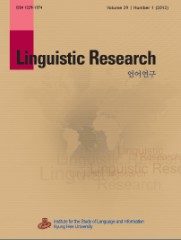Relations between handshape and orientation in simultaneous compounds in Korean Sign Language
Relations between handshape and orientation in simultaneous compounds in Korean Sign Language
- 경희대학교 언어정보연구소
- 언어연구
- 제40권 제1호
-
2023.03119 - 150 (32 pages)
-
DOI : 10.17250/khisli.40.1.202303.005
- 2

The purpose of this paper is to examine the status of orientation relative to handshape in sign phonology. There have been two competing views on the status of orientation: one in which orientation is taken to be a subcategory of handshape, and the other in which orientation is taken to have an equal status with handshape. We assess the predictions made by the competing views involving the possibilities of total assimilation of handshape and orientation, partial assimilation of orientation, and partial assimilation of handshape, through the analyses of simultaneous compounds in Korean Sign Language (KSL). It is shown in the paper that simultaneous compounds in KSL can be analyzed to involve not only total assimilation and partial assimilation of orientation but also partial assimilation of handshape, which is possible only under the view that orientation is independent of handshape. Based on the discussion, we conclude that orientation and handshape are parallel categories that distinguish meaning in the phonology of sign language.
1. Introduction
2. Two different ways of specifying hand orientation
3. Consequences of the differing hypotheses on hand orientation
4. Assimilation in simultaneous compounds in KSL
5. Conclusion
References
(0)
(0)